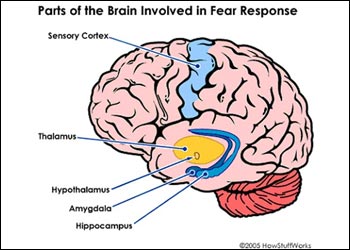“F-E-A-R has two meanings: ‘Forget Everything And Run’ or ‘Face Everything And Rise’.
The word itself derives from the old English word ‘feur’, meaning “a sudden calamity or danger.” Fear is one of the most basic human emotions. Fear is an ordinary part of life. Some fears may be overcome quickly; others may continue, in varying degrees, for a lifetime. From the time we’re infants, we are equipped with the survival instincts necessary to respond with fear when we sense danger or feel unsafe. Like all emotions, fear can be mild, medium, or intense, depending on the situation and the person.
Difference between Fear and Phobia :

Fears and phobias are related, but they are quite different in some ways. A phobia is an intense fear reaction to a particular thing or a situation. Some phobias develop when we have a scary experience with a particular thing or situation. Anxiety experienced in such situation tend to become so strong that it interferes with the quality of life and its ability to function. Whereas, fear is an emotional response to a real or perceived threat.
Science provides knowledge and insight into why we experience fear and why sometimes our fears seem out of control.
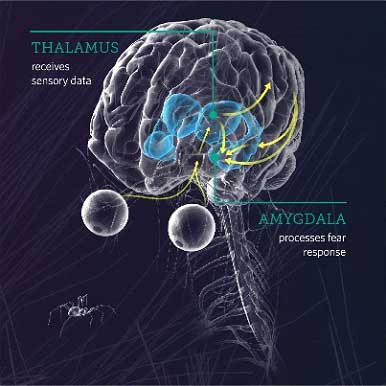
It is programmed into the nervous system and works like an instinct. When we sense danger, the brain reacts instantly, sending signals that activate the nervous system. Sensory information reaches thalamus in the brain which in turn activates various glands, which tend to produce a surge of hormones that affect one’s body. Past memories of fear get activated if sensory data passes in cortex and hippocampus A tiny brain structure called the amygdala (pronounced: uh-mig-duh-luh) keeps track of experiences that trigger strong emotions.
Signs seen in a person with fear

The heart beat gets faster, breathing speeds up, muscles get tensed. Some people might notice sensations in the stomach, head, chest, legs, or hands. This is what scientists call the “fight or flight” response. On the positive front, a fear can be healthy if it cautions a person to stay safe around something that could be dangerous. For instance, a scientist may be driven to formulate a vaccine because he fears the consequences of a fatal disease. Fear, although a recognised emotional state, is viewed as an unwelcome emotion, caused by the threat of danger and thereby regarded as an obstacle to success. It causes more caution than is necessary. So, on the negative side, fears and phobias may be overwhelming for eg., an exam fear in a student may make him give up his/her studies or become addicted to drugs.

Let us scrutinize fear through a myriad of lenses as mentioned in Jaina
āgamas like Ācāraṅga, Sutrakrutāṅga, Sthānāṅga, Dasāśrutaskhanda, Vipāka with respect to fear factors. Mahavira has given comprehensive assessment of fear in all of its ramifications. Fear is a great enemy of success. Clinging to life and body or sensuous pleasure are the main causes of all fear.
पास लोए महब्भयं – Ayaro – 6.1.14
Mahavir is saying look! (perceive) world is full of extreme fear. When Mahavir got enlightened he saw through his kevaljñāna that everyone was within the periphery of fear!!
As per Jainism, fear is one among four saṃjñas (Jivābhigam) or ten saṃjñas (Sthānāṅga). Among the four saṃjñas mentioned are āhara (food), bhaya (fear), maitun (sensual pleasure), parigraha (possession). In Sthanaṅga one finds ten types of saṃjñas which is extension to the common four saṃjñas. Fear is one among the four saṃjñas. Saṃjñas is an instinctual sensation. It arises due to udaya bhāva. It occurs without the assistance of sense organ and mind. All types of worldly beings have saṃjñas in a minimum- maximum intensities. Though all the beings have all the four saṃjñas, it is generalised that animals have āhāra saṃjñas, hellish beings have fear saṃjñas, humans have maituna saṃjña and celestial beings have parigraha saṃjñas. The hellish being are in a constant state of fear due their own wrong deeds. It’s our own normal day to day experiences that when we act ill-legally or unethically, we are in fear of being caught red-handed.
When we crave beyond the level of necessities of life, saṃjñas creep in. We are never aware how we get succumbed to a foreign element which tends to become an inbuilt mechanism within us. This happens due to our deluded state of mind. So, with respect to bhaya saṃjñas, what paralysis does to the physical body, fear does to the mind. It is the most destructive emotion. It breaks down the nervous system and undermines health. It creates worry and renders happiness and peace of mind practically impossible.
Seven states of fear as mentioned in Dasāśrutaskhanda, Aāvaśyaka (Saman-sutra), Sarvārthasidhi, Sthanaṅga, Samavayāṅga sutras etc.
Sāt (seven) bhaya sthān or seven states where possibility of fear exists as found in several sutras are –
- Iha loka-bhaya: Fear of present world and fear from same species. Same species means fear among animals within themselves (lion-deer, cat-mouse). Fear within human beings like thief, enemy, cruel people. Fear also exists within various relationships like employer-employee, teacher-student, husband-wife relationships etc. indirectly this state of fear, leads to himsa (violence). The fear of society is included in this category. Weakness is the Pandora of fear. Women are mostly used as a scapegoat in the name of religion and culture because they are considered physically and mentally weak.
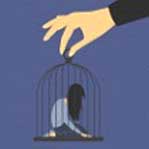
Among the five types of himsa as quoted in Ācāraṅga sutra 4th chapter of samyak darśan, “when you are ruling over someone (śāsan), it is also a form of himsa.” The word used is śāshan and not anuśāsan (discipline).
Separation from our loved ones is an inevitable fact of life. We fear losing the companionship of our dear ones, be it family members or be it friends. We are all like the logs of wood floating in the endless ocean of samsāra. For some period of time, we come in contact with a few logs termed as (ṛunānubhanda/bonding) with our friends and relatives, but then we drift apart. In the future, we will come in contact with the same beings (logs) again and then drift apart again. This is the true nature of this world, a reality that we should not deny.
- Para-loka-bhaya: Fear of the next world or fear from other species between animal, celestial, Hellish being. This fear can be factual like fear of lizard, snake, lion (for humans) or fear from celestial beings (evil spirits). Or it can also be a kind of hallucination.
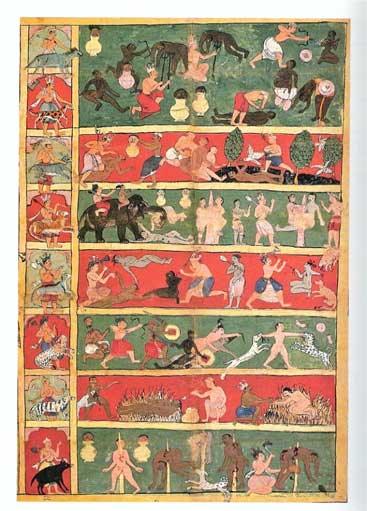 Fig of Hellish beingsIn terms of present situation, we humans are facing the fear of virus which is a form of para-loka bhaya.
Fig of Hellish beingsIn terms of present situation, we humans are facing the fear of virus which is a form of para-loka bhaya.

- Ādāna-bhaya: Fear of losing property due to theft etc. The third cause of fear is that of losing our possessions or financial security out of theft, fraud or such ill-legal means. This fear can be overcome by thoroughly planning our lives so that the chances of loss are minimized. The second solution of this type of fear is to understand through law of dharma and karma, that the possessions are never permanent. Money is like a rotating wheel that travels from one place to another. Change is a fact of life. If we are rich today, we may be poor tomorrow or vice versa. This understanding should make us become less attached to our material possessions, which can never be our constant companions.
- Akasmāt bhaya: Gripped with sudden fear without any external cause. People are always suffering, either about what happened yesterday or what may happen tomorrow. Being fearful means, you are suffering that which does not exist. So, the suffering is always about that which does not exist, simply because we are not rooted in reality, we are always rooted in our mind. In deep contemplation, one gets the insight that the attachment to the known and the unwillingness to let go, also breeds fear.

“One is never afraid of the unknown; one is afraid of the known coming to an end.” J. Krishnamurti.
- Ajivikā-bhaya: Fear of losing means of livelihood. In the current pandemic situation many have faced the hardship of losing livelihood. It also involves fear from the non- living which means earthquakes and other natural calamities where we tend to lose our livelihood.
- Aśloka-bhaya or Apayash bhaya: Fear of the society, one’s reputation, fear of losing one’s status and what others would say and think about one self. It is stated in Ācāraṅga sūtra, 1st chapter, four reasons as to why we tend to do himsa. Four reasons are –
- livelihood,
- for fame and status,
- for holding wrong notions with respect to birth-death and liberation and
- Self-preservation.
So, one reason for himsa among the four is to maintain one’s status. Himsa always leads to fear. When one causes fear to others, he or she has to endure its repercussion.

- Maraṇa bhaya- Fear of death. Self-preservation is a basic trait of all living beings. No one wants to die or get harmed. Accordingly, the fear of death or injury is the major cause of fear in human beings. Death of the body is merely a milestone in the journey of the soul. This journey completes when the soul achieves liberation and arrives at the abode of the liberated beings, located at the final frontier of the universe. Before death catches one off-guard, it is one’s duty to keep purifying the soul. The purer the soul is at the time of death, the better the chances are to get a more favourable next birth to continue the journey of purification. Only with 100 percent purity based on 100 percent nonviolence can a soul achieve liberation. One should not fear death but celebrate it as the ultimate demonstration of minimizing greed and violence. Fear of death should encourage you to live a life that is compassionate toward other living beings.
The above seven factors are briefly enumerated, but there are several types of fears which a living being undergoes and can be classified in any of the seven. We tend to face all seven bhaya in the present Covid-19 scenario. We can overcome unnecessary fears by giving ourselves the chance to learn and gradually get used to the thing or situation we are afraid of.
How to overcome fear?
A therapist might teach relaxation practices such as specific ways of breathing, muscle relaxation training, or soothing self-talk. These can help people feel comfortable and bold enough to face the fears on their list. As somebody gets used to a feared object or situation, the brain adjusts how it responds and the phobia is overcome. When fear gets transformed in its opposite (pratipakṣa) ‘nirbhaya’ state, it functions as a vital, life-saving force for e.g., many successful leaders survived through this instinct with the fear of failure.
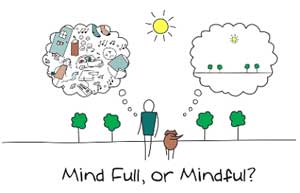
As per Jainism, Nir-bhaya and A-bhaya are both ‘Fear Free Zones’ where one experiences state of fearlessness but how to reach these states, what is the difference between the two? To find out the real solution one needs to do anuprekṣā (mindfulness) and try to find permanent solutions.
In order to come in the zone of ‘nirbhaya’ one should develop the attitude of compassion, feeling of gratitude which is opposite (pratipakṣa) of fear. Indeed, fear itself may act as a powerful motivator. ‘There is no courage without fear’; and transforming from the ‘fear barrier’ may be less frightening than living with our underlying and long-term fears. Meghkumar the son of king Srenika, faltered on the same night after taking initiation. Mahavira reminded Meghkumar of his compassionate act when he was an elephant in his previous birth and the hardship he had undergone and invited death to save a rabbit out of compassion. Meghkumar was lucky enough because Mahavira was there to show him the right path.
Prince Meghkumar’s previous birth.
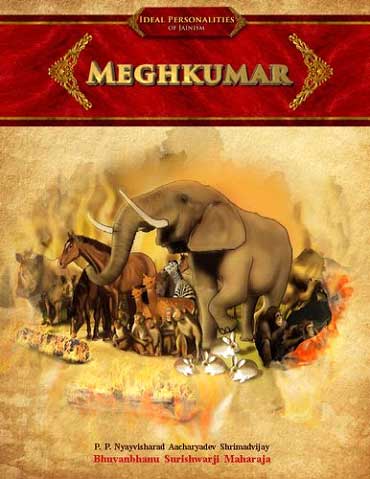
It makes more sense for us to co-operate rather than compete, in fact, our survival as a species depends on it. Dāna done out of compassion helps us in inculcating the virtue of sharing and giving. It also helps in developing our inner compassionate virtue. There are nine types of dāna or merit done out of compassion or kindness mentioned in the punya tattva, like anna-punya (offering food), pāna-punya (offering water), offering clothes, layan-śayan punya (giving dwelling places), involving oneself in good thought, speech and action and attitude of reverence. In 9th Sthānāṅga sūtra it is said that dāna (charity), if done out of fear then such a dāna is useless with respect to inculcating the virtue of compassion. The 18th chapter of Uttaradhyayana sutra which is considered as the last sermon of Mahavir, enlightens about cause of fear and technique to enter in the state of Abhaya – the fear-less zone. We come across in Namothuṇam sutra, the seven dāna i.e. giving knowledge to others, saving someone’s life etc among which ‘abhaya-dayāṇam’ is considered as the highest and the best of all merits and charity in freeing oneself and others from all kinds of fears. Similarly, the Hindu text Bhagawat Gita chapters 4th, 11th, 18th also reflects on the fear and how to overcome it.
Though both Abhaya and Nirbhaya are states where there is no fear, but nirbhaya is restricted. It is relative. There are chances that we come back from nirbhaya fearlessness to the state of bhaya (fear). Whereas Abhaya is that state where we do not return back to the state of fear. It is an absolute state of fearlessness.
Mahavir has given us key to enter into the state of nirbhaya in the present scenario.
पुरिसा तुममेव तुमं मित्तं , किं बहिया मित्तमिच्छसि ? Ayaro 3. 2. 62
Meaning: Man! You are yourself a friend, why search outside for a friend?
Today, we truly not only understand but are also experiencing this fear in the form of covid-19. If we can grasp the true meaning of this sutra, then we voluntarily can observe all the norms of COVID-19 like masking, maintaining social distancing etc. If taken positively, we have been given the opportunity to delve within ourselves and find out who we are and what is our goal.
Whether it is a fear of spiders, a fear of the dark, a fear of heights or the current scenario of pandemic, to understand the physical and emotional responses that we call fear and using our ancient knowledge and wisdom of seers, is the first step towards conquering it. One should ponder, and get insights about all other fears mentioned above. Gradually (and safely) facing fear helps to overcome it. One should neither live in fear nor put other living beings in a state of fear. With the right coaching and support, it can be surprising how quickly fear can melt away.
Ravindranath Tagore in his Gitanjali has quoted a beautiful poem, “Where the mind is free and the head is high — In to that heaven of freedom, my father, Let My Country Awake!”

Jacques Derrida (1930–2004) French philosopher and the founder of deconstruction says, “Rendering delirious that interior voice that is the voice of the other in us.” Fear is the shackle holding us captive. It is important for the mind to be free of fear. Just as food is essential for the body, it is also essential for the mind to be free of fear. Being fear-free is a must for being humanitarian as well as for equality.
सव्वओ पमत्तस्स भयं, सव्वओ अपमत्तस्स नत्थि भयं – (Samaṇa Suttam,166)
Meaning: A man is engulfed in fear when he is in state of negligence. There is no fear to a man who is in state of vigilance. The sutra given by Mahavir is to transcend the fear and enter into the state of ‘A-bhaya’. When one is in a state of aparigraha and living in absolute moment (vartamān kṣana), one perceives that there is no fear.

